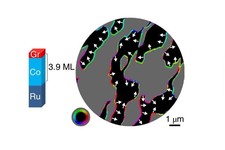
28/06/2018
Work performed in collaboration with French scientists at Berkeley Lab's Molecular Foundry reveal exotic spin properties that could lead to new form of data storage
In a recent work [1] researchers found that electronic and magnetic properties of graphene layered with ferromagnet create tiny swirling patterns where the layers meet, and this effect gives scientists hope for controlling the direction of these swirls and tapping this effect for a form of spintronics applications known as “spin-orbitronics” in ultrathin materials. The ultimate goal is to quickly and efficiently store and manipulate data at very small scales, and without the heat buildup that is a common hiccup for miniaturizing computing devices.
More information here. Image credits: Berkeley Lab and Nature Materials 17, 605–609 (2018).
News suggested by: Lucian Prejbeanu (Spintec, France).
[1] Significant Dzyaloshinskii–Moriya interaction at graphene–ferromagnet interfaces due to the Rashba effect, Nature Materials 17, 605–609 (2018). Freely accessible preprint arXiv:1704.09023.
The possibility of utilizing the rich spin-dependent properties of graphene has attracted much attention in the pursuit of spintronics advances. The promise of high-speed and low-energy-consumption devices motivates the search for layered structures that stabilize chiral spin textures such as topologically protected skyrmions. Here we demonstrate that chiral spin textures are induced at graphene/ferromagnetic metal interfaces. Graphene is a weak spin–orbit coupling material and is generally not expected to induce a sufficient Dzyaloshinskii–Moriya interaction to affect magnetic chirality. We demonstrate that indeed graphene does induce a type of Dzyaloshinskii–Moriya interaction due to the Rashba effect. First-principles calculations and experiments using spin-polarized electron microscopy show that this graphene-induced Dzyaloshinskii–Moriya interaction can have a similar magnitude to that at interfaces with heavy metals. This work paves a path towards two-dimensional-material-based spin–orbitronics.






